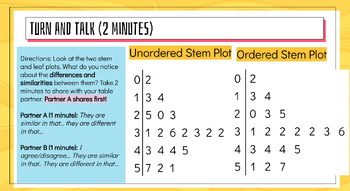Lesson 1 PowerPoint: One Variable Data for Statistics: Dot Plots, Histograms,etc
- PPTX
Description
This is a lesson (on powerpoint) about statistical distributions. The lesson includes practice problems and vocabulary relating to dot plots, stem plots, and describing/comparing statistical distributions. This is for secondary math (high schoolers). It includes some data collection activities and requires students to get involved in the lesson. If you teach with a tablet, iPad, or smart board, this template is writing-friendly. You can write on the presentation or edit it as you need for your class. Warm ups are also included in the lesson.
If you teach with Stats Medic, this lesson is aligned to the first chapter in Stats Medic. The lesson covers about two 95-minute classes.
The ppt best downloaded into Google Drive and edited as you need for your class. If you teach with StatsMedic, this lesson is directly in alignment with the cadence of StatsMedic lessons and activities. Please do not make this public and/or share without permission. Thank you!



